
Edward Winter
He dedicated his life to chess-playing, touring, writing, teaching and analysing. Despite only occasional participation in first-class events, he scored victories over all the leading masters of the time (Anderssen, Blackburne, Chigorin, Mackenzie, Mason, Paulsen, Steinitz and Zukertort). He also acquired world renown as an unassuming showman who gave large simultaneous displays and blindfold séances, invariably producing a cluster of glittering moves. He was born in Suwałki, Poland on 7 September 1837; a law student, he left his country following the 1863 insurrection and spent most of his adult life in France. When he died the obituaries were ample and generous, but today his name is, at best, only dimly remembered. There are brief entries in some reference books, but by no means all. For instance, the Larousse du jeu d’échecs (1997) had nothing to say about him.
The player in question is Samuel Rosenthal. In particular, his many ‘informal’ brilliancies have been forgotten, and it is on these that the present article will focus, offering a selection from the dozens which were published in the latter part of the nineteenth century but are never seen nowadays.

The Café de la Régence, 1874. Rosenthal is second from the right in the bottom right-hand corner.

From a queen’s knight odds game in which Rosenthal was facing two consulting amateurs (published on pages 239-241 of La Stratégie, 15 October 1869). The opening moves were 1 e4 e5 2 Nf3 Nc6 3 Bc4 Bc5 4 b4 Bxb4 5 c3 Ba5 6 O-O Nf6 7 d4 Nxe4 8 d5 Nd6 9 Bb3 e4 10 dxc6 exf3 11 Re1+ Kf8 12 Qxf3 bxc6 13 Ba3 Qf6 14 Rad1 Qxf3. Instead of retaking the queen, Rosenthal played:
15 Rxd6 Qxf2+ 16 Kxf2 Bb6+ 17 Kg3 c5 18 Rd3 g6 19 Bxf7 Kxf7 20 Rf3+ Kg7 21 Re7+ Kh6 22 Bc1+ g5 23 Rf6+ Kh5 24 Re5 Rg8 25 h3 Rg6 26 Rf7 h6 27 Kh2 c6 28 Be3 (Missing a mate in three.) 28…c4 29 g4+ Kh4

White announced mate in four moves. In his annotations Rosenthal did not give the mating line, but it is exceptionally beautiful: 30 Rc5 and if 30…Bc7+ then 31 Rf4.
The above game also appeared on pages 66-68 of Gossip’s
Vest-Pocket Chess Manual, which identified the Black allies
as ‘the late Duke of Brunswick and M. Fery d’Escands’. For the
mate in four after Black’s 29th move Gossip gave an incorrect move
(30 Bd2).
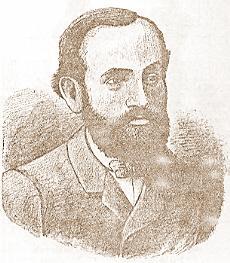
Samuel Rosenthal
The next position arose in a simultaneous game in Sheffield in 1871:
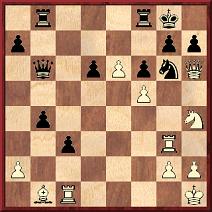
32 fxg6 gxh6 33 gxh7+ Kh8 34 Ng6+ Kxh7 35 Nxf8+ Kh8 36 Ng6+ Resigns.
There are contradictory accounts of the occasion and of Black’s identity. The full game was given on pages 242-243 of the 1871 Chess Players’ Quarterly Chronicle as having been played against Cockayne in a 14-board simultaneous display in Sheffield on 3 February 1871. The magazine also reported that when Rosenthal gave a second exhibition (18 boards) in the same city one of the victors was Cutler, in a game which it printed on pages 272-273. However, when the above combination was published in La Stratégie (15 January 1872, pages 6-7), with brief notes by Rosenthal himself, Black’s name was given as Cutler and the game was said to have occurred in a 25-game display.
Another game from the 1871 Quarterly (pages 292-293):
Samuel Rosenthal – Count Isouard
Occasion?
(Remove White’s queen’s knight.)
1 e4 e5 2 f4 exf4 3 Nf3 g5 4 Bc4 g4 5 O-O gxf3 6 Qxf3 Qf6 7 e5 Qxe5 8 Bxf7+ Kxf7 9 d4 Qf6 10 Bxf4 Bg7 11 Qh5+ Qg6 12 Bd6+ Ke8
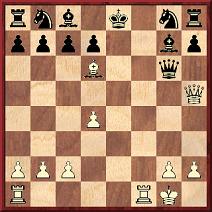
13 Qe5+ Qe6 14 Qxg7 Qxd6 15 Rae1+ Qe7 16 Qf8 mate.
The conclusion to an offhand game against strong opposition:
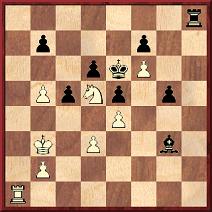
Samuel Rosenthal – A.B. Skipworth, Bilsdale, 1871.
42 Ra7 Rb8 43 Ka4 Bf4 (43…Be1 was the right move.) 44 Ka5 g4 45 Kb6 g3 46 Kc7 Re8 47 Kxb7 g2 48 Ra1 (A spectacular alternative was 48 Nc7+ Kd7 49 Nxe8 g1(Q) 50 Kb6+ and 51 Kc6, with mate to follow.) 48...Rg8 49 Kc7 g1(Q)

50 Ra6 Rc8+ 51 Kxc8 Qg8+ 52 Kc7 Qf8 53 b6 Qe8 54 b7 Qd7+ 55 Kb6 Qd8+ 56 Ka7 Qd7 57 Ka8 and wins.
Source: The Chess Players’ Quarterly Chronicle, 1871, pages 300-301.
The event that probably brought Rosenthal the most publicity was his simultaneous display in Paris of 24 January 1873, against 28 players, a very high figure for the time. Rosenthal scored +22 –4 =2. Below are three games from the 14 published by La Stratégie that year.
Samuel Rosenthal – Milleriot
Paris, 24 January 1873
Philidor’s Defence
1 e4 e5 2 Nf3 d6 3 d4 Bg4 4 Bc4 Bxf3 5 Qxf3 Nf6 6 Be3 Nbd7 7 Nc3 c6 8 O-O-O Be7 9 g4 O-O 10 h4 Ne8 11 g5 g6 12 h5 Bxg5 13 hxg6 Bxe3+ 14 fxe3 hxg6 15 Qh3 Kg7 16 Qh6+ Kf6 17 Rdf1+ Ke7
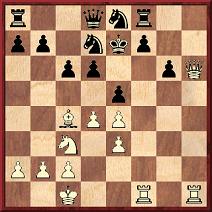
18 Qxf8+ Kxf8 19 Rxf7+ Kg8 20 Rxd7+ d5 21 Rxd8 Rxd8 22 exd5 cxd5 23 Bxd5+ Resigns.
Samuel Rosenthal – Philippe
Paris, 24 January 1873
Falkbeer Counter-Gambit
1 e4 e5 2 f4 d5 3 exd5 Qxd5 4 Nc3 Qe6 5 Nf3 exf4+ 6 Kf2 Be7 7 d4 g5 8 Ne5 Nh6 9 Bc4 Qf5 10 Qh5 Ng4+ 11 Nxg4 Qxg4 12 Qxf7+ Kd8 13 Re1 Re8 14 Nd5 Nc6
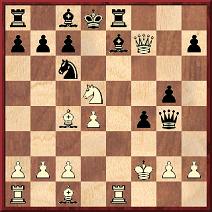
15 Qxe8+ Kxe8 16 Nf6+ Kf8 17 Nxg4 Bxg4 18 c3 Rd8 19 h3 Bf5 20 Bd2 a6 21 Be6 Bg6 22 Re2 and Black resigned after a few more moves.
Samuel Rosenthal – Landowski
Paris, 24 January 1873
King’s Gambit Accepted
1 e4 e5 2 f4 exf4 3 Nf3 d6 4 d4 g5 5 h4 g4 6 Ng5 Qf6 7 Nc3 c6 8 Bc4 Nh6 9 O-O d5 10 exd5 Bd6 11 Nce4 Qe7 12 Nxd6+ Qxd6 13 Bxf4 Qg6 14 Be5 O-O 15 Rf6 Qh5 16 Qd3 Bf5 17 Rxf5 Nxf5 18 Qxf5 Qg6 19 Qxg4 h6
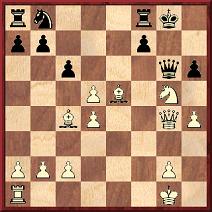
20 Nxf7 Qxg4 21 Nxh6+ Kh7 22 Nxg4 Kg6 23 Bd3+ Kh5 24 Nf6+ Kxh4 25 Kf2 Nd7 26 Rh1+ Kg5 27 Rh5 mate.
Now a king hunt published in La Stratégie, 15 July 1873, page 207.

Samuel Rosenthal – F.W., Paris,
8 June 1873 (queen’s knight odds).
White won by 22 Nf6 gxf6 23 exf6+ Kf7 (It would have been interesting to see Rosenthal trying to demonstrate a win after 23…Qxf6 24 Rd7+ Kxd7.) 24 Qc7+ Kxf6 25 Rd6+ Kg5 26 Rd5+ (Elegant as ever.) 26…Kxg4 27 Qf4+ Kh3 28 Qf3+ and mate next move.

Samuel Rosenthal (right)
On 27 February 1874, Rosenthal gave another simultaneous display before a large crowd which included a prince, a marquis, a baron and a couple of counts. They watched him take on 26 players, with a final result of +19 –1 =6. Rakowsky was the sole winner. The longest time Rosenthal took to go round the boards was 10 minutes, i.e. an average of 23 seconds per move. By midnight only one game had been resigned, but many others were ‘à l’agonie’, and by a quarter-past two in the morning the final game had ended in a draw.
La Stratégie published seven games from the event, and the best three are given here.
Samuel Rosenthal – Robert
Paris, 27 February 1874
Vienna Game
1 e4 e5 2 Nc3 Nc6 3 Nf3 Bc5 4 Nxe5 Bxf2+ 5 Kxf2 Nxe5 6 d4 Qh4+ 7 g3 Qf6+ 8 Kg2 Ng6 9 Bc4 Qd8 10 Rf1 f6 11 e5 b5 12 Nxb5 Bb7+ 13 Kg1 d6 14 exd6 cxd6 15 Qh5 Qe7 16 Bf4 O-O-O 17 Rae1 Qf8 18 Be6+ Kb8 and White announced mate in three moves (19 Qc5, etc.).
Samuel Rosenthal – Dermenon
Paris, 27 February 1874
Vienna Game
1 e4 e5 2 Nc3 Nc6 3 Nf3 Bc5 4 Nxe5 Bxf2+ 5 Kxf2 Nxe5 6 d4 Ng6 7 Bc4 d6 8 Rf1 N8e7 9 Kg1 O-O 10 Qh5 c6 11 Bg5 b5 12 Bb3 a5 13 a3 Ra7 14 d5 Qb6+ 15 Kh1 c5 16 a4 c4 17 Ba2 f6 18 Bd2 bxa4 19 Bxc4 Ne5 20 Be2 Bd7 21 Nxa4 Qd4 22 Bc3 Qxe4 23 Bf3 Nxf3 24 Qxf3 Qxc2 25 Nb6 Bb5 26 Rf2 Qg6 27 Re1 Nc8 28 Nxc8 Rxc8 29 Qe3 Qf7 30 Qb6 Ba6 31 Qxd6 a4 32 Rf3 Bb5 33 Re6 Bd7
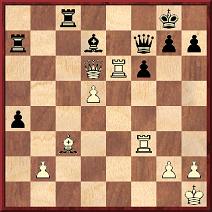
34 Rexf6 gxf6 35 Rg3+ Kh8 36 Qxf6+ and mate next move.
Samuel Rosenthal – Najotte
Paris, 27 February 1874
French Defence
1 e4 e6 2 d4 d5 3 Nc3 Bb4 4 exd5 exd5 5 Bd3 Be6 6 Nf3 Nf6 7 O-O Nbd7 8 Ne5 O-O 9 f4 Nxe5 10 fxe5 Ne8 11 Qh5 g6 12 Qh6 Be7 13 Ne2 c6 14 Ng3 Ng7 15 c3 Rc8 16 Be3 b6 17 Rf2 Rc7 18 Raf1 f6 19 exf6 Bxf6

20 Bg5 Rcf7 21 Rxf6 Rxf6 22 Rxf6 Rxf6 23 h4 Ne8
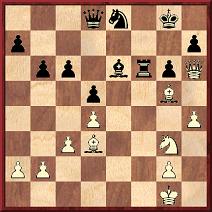
24 Nh5 gxh5 25 Qxh7+ Kf8 26 Bg6 Ng7 27 Qh8+ Bg8 28 Bh7 Kf7 29 Bxf6 Kxf6 30 Bxg8 Qe7 31 Kh2 c5 32 Qh6+ Kf5 33 Bh7+ Kg4 34 Qg6+ and mate next move.
Another brilliancy from the same year:
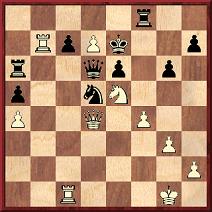
Samuel Rosenthal – Blanchard, Trouville, September 1874 (queen’s knight odds game).
White won with 32 Nc6+ Rxc6 33 Rxc6 Qxc6 34 Qg7+ Rf7 35 Qxf7+ Kxf7 36 d8(N)+.
Source: La Stratégie, 15 November 1874, page 342.
More spectacular moves from Rosenthal:
Samuel Rosenthal – Comte de l’Eglise
Paris, 20 September 1875
Muzio Gambit
1 e4 e5 2 f4 exf4 3 Nf3 g5 4 Bc4 g4 5 O-O gxf3 6 Qxf3 Qf6 7 e5 Qxe5 8 d3 Bh6 9 Bd2 Ne7 10 Nc3 Nbc6 11 Rae1 Qf5 12 Nd5 Kd8 13 Bc3 Rg8
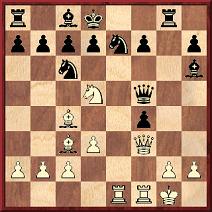
14 Rxe7 Nxe7 15 Bf6 Bf8 16 Re1 c6 17 Re5 Qg4 18 Rxe7 cxd5 19 Rxf7+ Kc7 20 Be5+ Kd8 21 Rxf8+ Ke7 22 Bd6+ Kxd6 23 Qxd5+ Ke7 24 Qe5+ Kxf8 25 Qf6+ Ke8 26 Bf7+ Kf8 27 Bg6 mate.
Source: La Stratégie, 15 October 1875, pages 299-301.
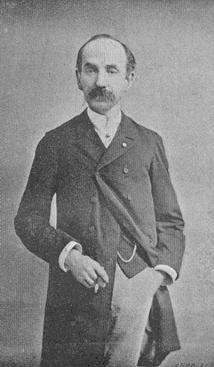
Samuel Rosenthal
Three further simultaneous display victories:
Samuel Rosenthal – Najotte
Paris, 28 January 1876
Evans Gambit Accepted
1 e4 e5 2 Nf3 Nc6 3 Bc4 Bc5 4 b4 Bxb4 5 c3 Ba5 6 d4 exd4 7 O-O dxc3 8 Qb3 Qf6 9 e5 Qg6 10 Nxc3 Bxc3 11 Qxc3 Nge7 12 Re1 Nd8 13 Ba3 Nec6 14 Bd3 Qh6 15 Re4 a6 16 Rh4 Qe6 17 Ng5 Qd5 18 Bc4 Qa5 19 Qf3 Nxe5 20 Re4 f6 21 Qh5+ g6
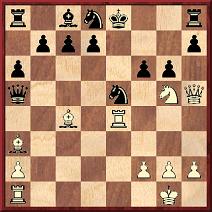
22 Nxh7 Qxa3 23 Qxg6+ Ke7 24 Qxf6+ Ke8 25 Qxh8+ Ke7 26 Qf8 mate.
Source: La Stratégie, 15 February 1876, pages 40-42.
Samuel Rosenthal – S. David
Paris, 28 January 1876
Falkbeer Counter-Gambit
1 e4 e5 2 f4 d5 3 exd5 Qxd5 4 Nc3 Qd6 5 Nf3 Nc6 6 Bc4 Be7 7 Bb3 h6 8 O-O Bf6 9 fxe5 Bxe5 10 Bxf7+ Kd8 11 Ne4 Qe7 12 d4 Bf6 13 d5 Ne5 14 d6 Nxf3+ 15 Rxf3 Qxe4 16 dxc7+ Kxc7 17 Bf4+ Be5
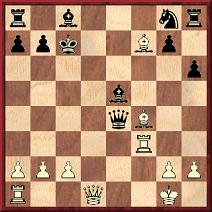
18 Rc3+ Kb8 19 Qd6+ Bxd6 20 Bxd6 mate.
Source: La Stratégie, 15 March 1876, pages 69-70.
Samuel Rosenthal – Baron Boissy d’Anglas
Paris, 28 January 1876
Evans Gambit Accepted
1 e4 e5 2 Nf3 Nc6 3 Bc4 Bc5 4 b4 Bxb4 5 c3 Bc5 6 d4 exd4 7 O-O d6 8 cxd4 Bb6 9 Nc3 Na5 10 Bg5 Ne7 11 Nd5 f6 12 Bxf6 gxf6 13 Nxf6+ Kf8 14 Ng5 Nxc4 15 Qh5 Kg7 16 Qf7+ Kh6

17 Ng4+ Bxg4 18 Qf6+ Kh5 19 Nf7 Ng8 20 Qxh8 Qf6 21 Qxh7+ Nh6 22 f3 Bxd4+ 23 Kh1 Be6 24 g4+ Kh4 25 Nxh6 Rh8 26 Nf5+ Kg5 27 f4+ Kg4 28 h3 mate.
Source: La Stratégie, 15 March 1876, pages 70-71.
Samuel Rosenthal – W.
Occasion?
(Remove White’s queen’s rook.)
1 e4 d5 2 exd5 Qxd5 3 Nc3 Qd8 4 d4 Nc6 5 Nf3 Bg4 6 d5 Ne5 7 Nxe5 Bxd1 8 Bb5+ c6 9 dxc6 Nf6 10 c7+ Nd7 11 cxd8(Q)+ Rxd8 12 Kxd1 e6 13 Re1 Ke7 14 Nxd7 a6 15 Nd5+ Kd6

16 Bf4+ Kxd5 17 c4+ Kd4 18 Be5+ Kd3 19 Re3 mate.
Source: La Stratégie, 15 March 1878, page 78.

Samuel Rosenthal
Now two games from a blindfold simultaneous display (eight boards):
Samuel Rosenthal – L. Vié
Paris, 10 February 1878
King’s Gambit Accepted
1 e4 e5 2 f4 exf4 3 Bc4 d5 4 Bxd5 Qh4+ 5 Kf1 g5 6 d4 Bg7 7 Nc3 Ne7 8 Nf3 Qh5 9 h4 h6 10 Kg1 Qg6 11 Ne5 Bxe5 12 dxe5 c6 13 Bb3 Rg8 14 hxg5 Qxg5 15 Qf3 Ng6 16 Rh5 Nh4 17 Rxh4 Qxh4 18 Bxf4 Be6 19 Rf1 Bxb3 20 axb3 Nd7 21 e6 fxe6 22 Bd6 O-O-O
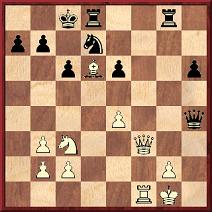
23 Nb5 b6 24 Nxa7+ Kb7 25 Nxc6 Kxc6 26 e5+ Kb5 27 c4+ Ka6 28 Ra1 mate.
Source: La Stratégie, 15 March 1878, pages 66-67.
Samuel Rosenthal – Feisthamel
Paris, 10 February 1878
Evans Gambit Accepted
1 e4 e5 2 Nf3 Nc6 3 Bc4 Bc5 4 b4 Bxb4 5 c3 Bc5 6 d4 exd4 7 O-O d6 8 cxd4 Bb6 9 Nc3 Na5 10 Bg5 f6 11 Bf4 c6 12 Bxg8 Rxg8 13 Re1 Kd7 14 e5 g5 15 Bg3 Bc7 16 exf6 Qxf6 17 Ne4 Qg6

18 Nc5+ Kd8 19 d5 cxd5 20 Qxd5 Nc6 21 Rad1 Ne7 22 Nxb7+ Bxb7 23 Qxb7 Rc8 24 Bxd6 Rg7 25 Bxe7+ Ke8 26 Qxc8+ Kf7 27 Qf8 mate.
Source: La Stratégie, 15 March 1878, pages 69-70.

Samuel Rosenthal during the London, 1883 tournament
In conclusion, two brevities from later in Rosenthal’s career:
Samuel Rosenthal (blindfold) – Several amateurs
Paris, 10 March 1887
Evans Gambit Accepted
1 e4 e5 2 Nf3 Nc6 3 Bc4 Bc5 4 b4 Bxb4 5 c3 Ba5 6 d4 exd4 7 O-O Nge7 8 Ng5 Ne5 9 Bb3 dxc3 10 f4 Bb6+ 11 Kh1 c2 12 Qh5 g6
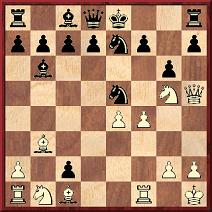
13 fxe5 gxh5 14 Bxf7+ Kf8 15 Ne6+ dxe6 16 Bh6 mate.
Source: La Stratégie, 15 March 1887, page 90.
One of eight games played blindfold:
Samuel Rosenthal – de Lamothe
Paris, 8 February 1888
Vienna Game
1 e4 e5 2 Nc3 Nf6 3 f4 Nc6 4 fxe5 Nxe5 5 d4 Nc6 6 e5 Ng8 7 Nf3 d5 8 Bb5 Bb4 9 O-O h6 10 e6 f6 11 Ne5 Ne7 12 Nf7 Resigns
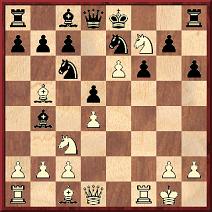
Source: La Stratégie, 15 February 1888, pages 47-48.
The illustration below is the best-known depiction of Rosenthal:
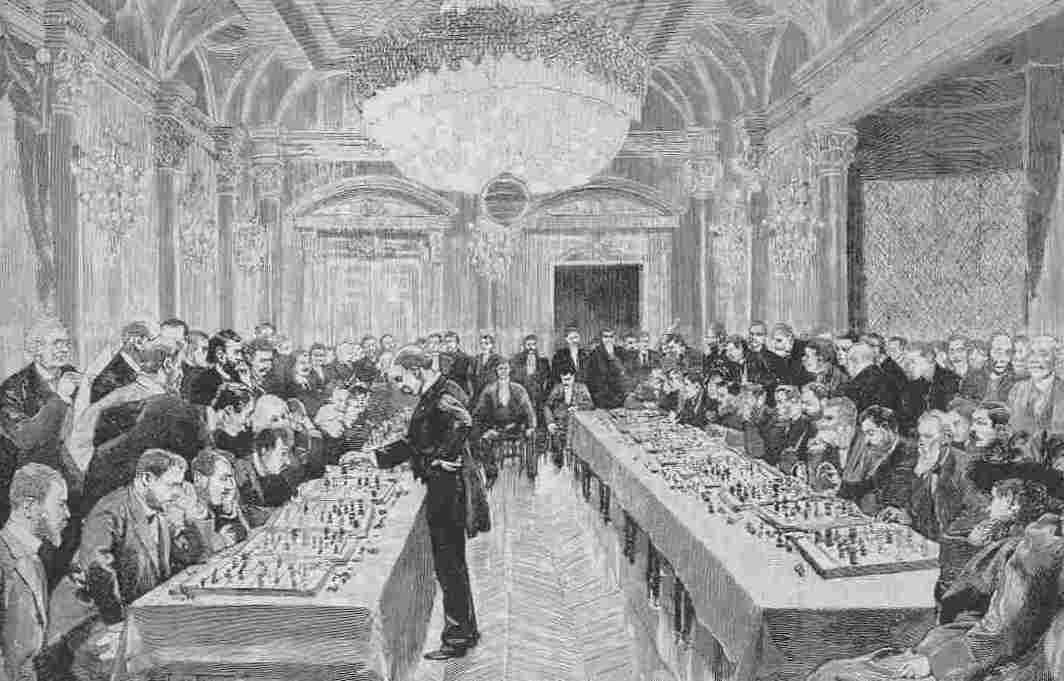
When published on page 41 of A History of Chess by J. Giżycki (London, 1972) it had the following caption: ‘The famous chessplayer Rosenthal giving a simultaneous display on 30 chess boards in Paris (1891). Drawing by Louis Tinayre.’ Page 369 of the 15 December 1891 issue of La Stratégie reported that on 1 December Rosenthal had given a 30-board display ‘dans la nouvelle et magnifique salle des fêtes du Grand Cercle et Cercle des Echecs de Paris’. It took place from nine in the evening until half-past two in the morning, and Rosenthal scored +26 –1 =3.
Rosenthal died in Neuilly-sur-Seine in September 1902. Although it is tempting to compare his exhibition play to that of Blackburne, who was four years his junior, their characters seem to have been almost complete opposites. Rosenthal had no taste for personal pyrotechnics, and it was his chess virtuosity alone that made him a successful showman. His obituary on pages 324-325 of La Stratégie, 20 October 1902 described him as a ‘nerveux’. Page 34 of the October 1889 Chess Monthly reported: ‘Physically, Rosenthal is not a strong man, and this accounts for his frequent breakdowns in matches and tournament play’. The magazine added, however, that ‘through his exemplary conduct and amiable manners he is the most popular chessplayer in France’.
Some of that popularity needs to be rekindled today. Let us hope that specimens of Rosenthal’s play will find their way into future anthologies of brilliant games and combinations. After all, chess writers have no bounden duty to rehash in perpetuity the old classics.
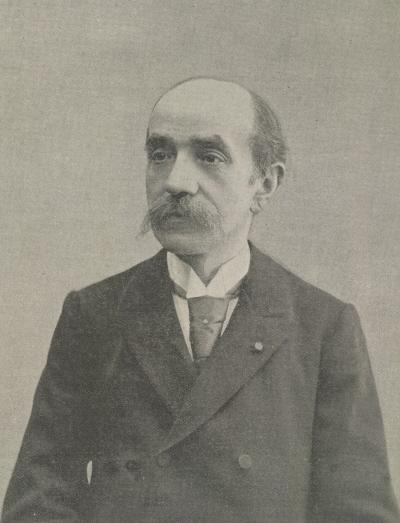
Samuel Rosenthal (Le Monde Illustré, 20 September 1902, page 288)
Note: The above is an expanded version of our article on pages 86-92 of the 7/1999 New in Chess.
From C.N. 2368:
A cursory feature about Rosenthal on page 43 of the January 2000 Europe Echecs stated that in 1880 he ‘narrowly’ (‘de justesse’) lost a match to Zukertort. In reality, Rosenthal’s score was +1 –7 =11.
Drawing attention to a bizarre report on page 96 of Le monde illustré, 5 February 1876, Jerry Spinrad (Nashville, TN, USA) comments:
‘Even though the report exaggerates the size of Morphy’s blindfold exhibition, stating that it was on 12 boards, it more or less dismisses as unimportant the fact that it was given blindfold. The writer suggests that Morphy, a lazy Creole, seemingly dozed in the comfort of an armchair and merely murmured his moves.Rosenthal’s over-the-board simultaneous display, in which he had to walk constantly, is regarded as far more impressive.’
(8611)
See also The Chess Masters of To-day by Leopold Hoffer.
To the Chess Notes main page.
To the Archives for other feature articles.
Copyright Edward Winter. All rights reserved.